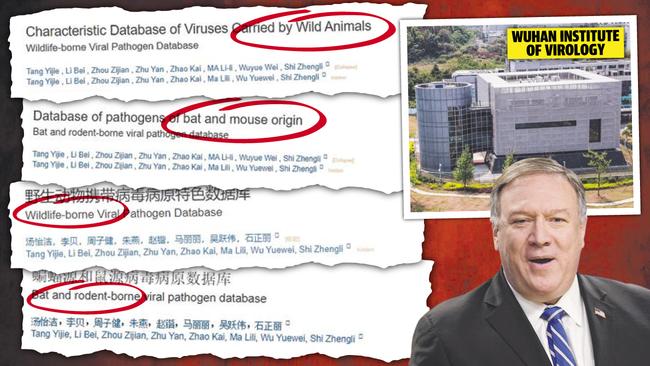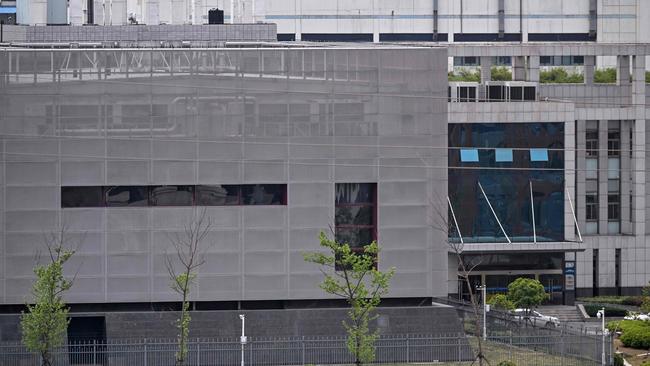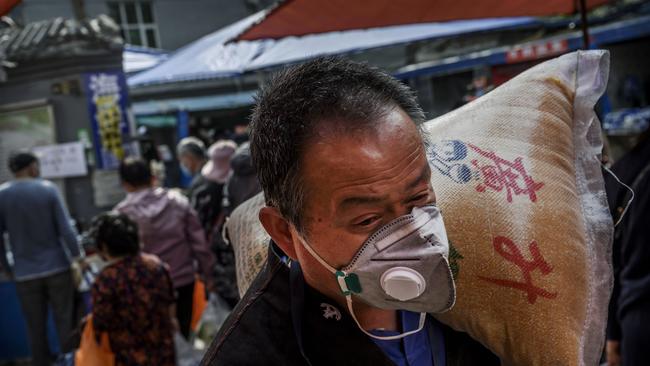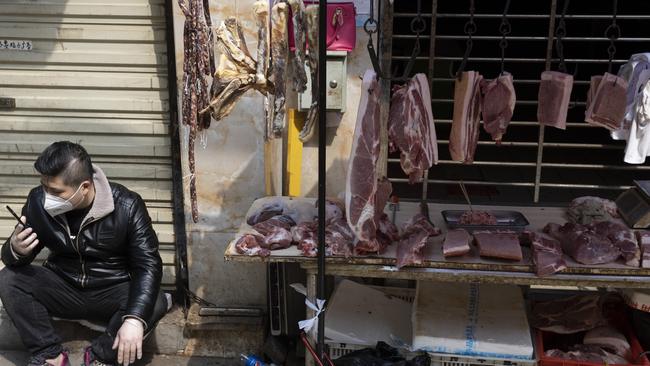Mystery of the missing data — substantial changes made to Wuhan lab’s bat virus files
Someone at the high-security Wuhan Institute of Virology censored its virus database in an apparent attempt to disassociate the laboratory from a novel coronavirus outbreak that would become a global pandemic, writes Miranda Devine.
- Wake up, Australia. We need to China-proof our economy
- Left-wing greenies turn on Michael Moore. Give him a medal
Days before the Wuhan wet market was bleached, whistleblowers punished and virus samples destroyed, someone at the high-security Wuhan Institute of Virology (WIV) censored its virus database in an apparent attempt to disassociate the laboratory from a novel coronavirus outbreak that would become a global pandemic.
This is what open source intelligence uncovered in the UK reveals.

Substantial alterations to the WIV database on the evening of December 30, the day before the World Health Organisation was alerted to the outbreak of a cluster of pneumonia cases in Wuhan, are just another indication that the Chinese Communist Party is hiding something when it comes to the origins of COVID-19.
MORE MIRANDA DEVINE
How Biden’s denial exposes the hypocrisy of the Left
Twiggy’s China kowtow is no favour to Australia
Chinese company linked to Forrest says birth defects ‘a disgrace’
The question of whether the virus came from the Wuhan wet market, as China insists, or leaked from the nearby WIV laboratory, where high-risk research into animal-to-human transmission of bat coronaviruses was being conducted, is at the centre of allegations of a cover-up and a worldwide clamour for an independent investigation into the source of the disease.

Shi Zhengli, the virologist known as China’s “Bat Woman” for her work with bat coronaviruses, directs the WIV’s Center for Emerging Infectious Diseases and is listed as the primary database contact.
On December 30, she was in Shanghai for a conference when she was summoned back to Wuhan with the news that a novel coronavirus had been detected in two pneumonia patients.
On the overnight train from Shanghai, according to a March article in Scientific American, she was stricken with worry about the coronaviruses.
“Could they have come from our lab?” she wondered.
After all, the closest known relative of this new coronavirus, a bat virus named RaTG13, was in her lab.
Weeks later, she would post a message on WeChat saying, “I swear with my life, [the virus] has nothing to do with the lab.”

But, at some point that night, while she was on the train to Wuhan, alterations were made to her database, which contained records of bat viruses transmitted to other wild animals.
Most of the changes were to delete the keywords “wildlife” or “wild animals”. This is significant because global health researchers say the virus jumped from bats to humans via another wild animal — the crucial “missing link in the COVID-19 transmission chain.
Shi’s used to boast her bat virus database was unique because it included data on virus variants in other wild animals.
Was her database censored to keep prying eyes away from references to cross-species transmission of viruses in wild animals?
For instance, the title of the database was changed that night from “Wildlife-borne Viral Pathogen Database” to “Bat and rodent-borne viral pathogen database”.

“Wild animal” was replaced with “bat and rodent” or “bat and rat” at least 10 times in the database. A reference to “arthropod vectors” also was removed.
Keywords which might facilitate searches potentially connecting the database with the outbreak also were deleted. “Wild animal samples”, “viral pathogen data”, “emerging infectious diseases” and “cross-species infection” were keywords associated with the original version.
On December 30 they were replaced with “bat”, “rodent” and “virus”.
“It looks like a rushed, inconsistent effort to disassociate the project from the outbreak by rebranding it,” says the British open source intelligence analyst who found the alterations.
“It’s a strange thing to do within hours of being informed of a novel coronavirus outbreak”.
He surmises that: “If the WIV had found the missing link between bat virus RaTG13 and SARS-CoV-2 [the virus that causes COVID-19] from an animal vector, it would have been in Shi’s database”.

There’s no conclusive evidence that any of the changes were made for sinister reasons.
But China’s lies and furtive actions since the outbreak leads us to believe the worst.
“This is an enormous crisis created by the fact that the Chinese Communist Party reverted to form, reverted to the kinds of disinformation, the kinds of concealment, that authoritarian regimes do,” Secretary of State, Mike Pompeo said in an interview Sunday with ABC.
“There is enormous evidence that [the Wuhan lab] is where this began …
“These are not the first times that we’ve had a world exposed to viruses as a result of failures in a Chinese lab.”
On Wednesday, Pompeo walked back his comments slightly at a press conference: “We don’t have certainty,” he said. “We’re all trying to get to clarity.”
China’s refusal to allow an investigation of the origins of the Wuhan virus, or even to share original virus samples, impedes the search for treatments and a vaccine. As if that weren’t bad enough, now it is threatening economic boycotts against countries like Australia which want an investigation.
“The CCP organisational and governmental culture is to cover up and ruthlessly control,” says a retired senior Australian intelligence officer who served in China.
“The arrest of frontline health professionals in January was standard practice.”
We don’t know why the changes were made to the WIV database.
What we do know is they were made the same day a young ophthalmologist, Dr Li Wenliang, warned colleagues in an online chat group about a “SARS-like coronavirus” among patients in the emergency department of a Wuhan Hospital.
Li was arrested two days later, along with seven other doctors, for “spreading rumours” and forced to recant. He died a month later, of coronavirus, aged 34.
